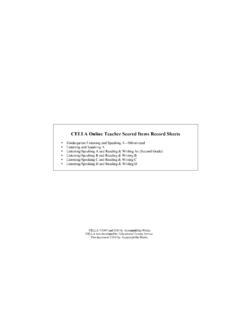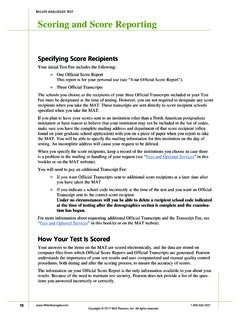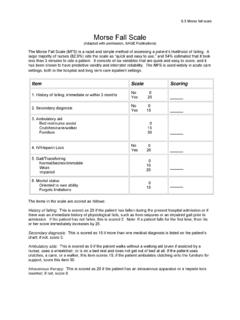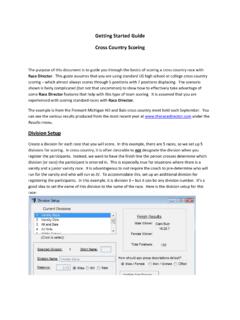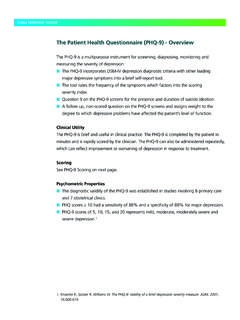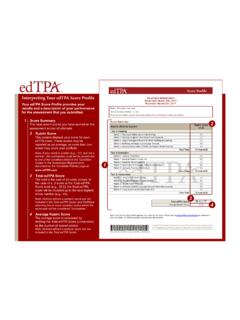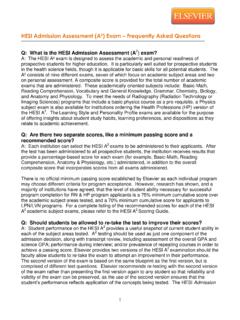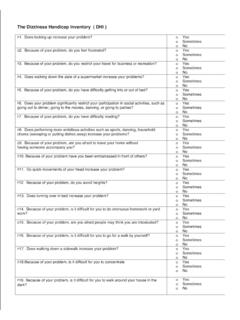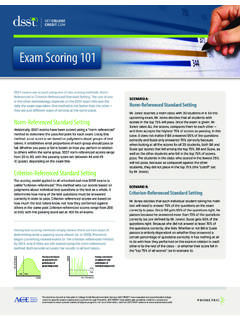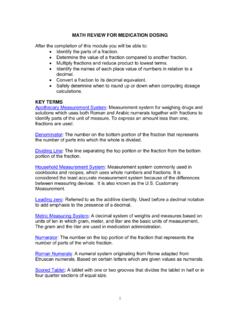Transcription of Patient ID Information Scored Patient-Generated Subjective ...
1 (0) (2) (3) (3) (3) Scored Patient -Generated Subjective global assessment (PG-SGA) History Boxes 1-4 are designed to be completed by the Patient . [Boxes 1-4 are referred to as the PG-SGA Short Form (SF)] 1. Weight (Se e Worksheet 1) In summary of my current and recent weight: Patient ID Inf ormation 2. Food Intake: As compared to my no rmal intake, I would rate my food intake during the past month as: unchanged more than usual I currently weigh about pounds less than usual (1) (0) I am about feet tall One month ago I weighed about pounds Six months ago I weighed about pounds I am now taking: normal food but less than normal amount little solid food only liquids only nutritional supplements (3) (1) During the past two weeks my weight has: very little of anything (4) decreased (1) not changed (0) increased (0) Box 1 only tube feedings or only nutrition by vein (0) Box 2 3. Symptoms: I have had the following problems that have kept me from eating enough during the past two weeks (check all that apply): no problems eating (0) 4.
2 Activities and Function: Over the past month, I would generally rate my activity as: no appetite, just did not feel like eating normal with no limitations (0) nausea (1) constipation (3) vomiting diarrhea (3) not my normal self, but able to be up and about with fairly normal activities (1) (1) (3) not feeling up to most things, but in bed or chair less than half the mouth sores (2) dry mouth (1) day things taste funny or have no taste (1) smell s bother me (1) (2) problems swallowing pain; where? (2) feel full quickly fatigue (1) able to do little activity and spend most of the day in bed or chair pretty much bedridden, rarely out of bed other** (3) (1) (1) ** Examples: depression, money, or dental problems Box 3 Box 4 FD Ottery, 2001, 2005, 2006, 2014 Email: or info@pt-glo bal. org Additive Score of the Boxes 1-4 A While height is not essential for scoring, the app calculates BMI Complete both 1 & 6 months; for scoring, use 1 mo if available.
3 Use 6 mos only if 1 mo is not available Box 1 max score = 5 points: up to 4 pts from wt loss + up to 1 point for past 2 wks Box 2 not additive; max = 4; use the highest score checked, no matter how many checked Pt should complete if possible; not professional or family unless needs help (sight, literacy, etc.) Score how the Patient self-rates his/her intake during the past month; this helps to address recent deficit / current risk Box 3 Any symptoms that Patient reports (checks off) that has kept them from eating enough during the past 2 weeks gets Scored . Add all points for Box 3 total score This is the WHO or ECOG performance status in Patient terms, Patient rates his/her activity level over the past month regardless of the cause inadequate intake, metabolic stress (corticosteroids, fever, inflammation, trauma) or significant inactivity. Remember, 1 week of complete bed rest is associated with up to 4% loss in lean tissue/muscle mass Worksheet 1 - Scoring Weight (Wt) Loss To determine score, use 1 month weight data if available.
4 Use 6 month data only if there is no 1 month weight data. Use points below to score weight change and add one extra point if Patient has lost weight during the past 2 weeks. Enter total point Wt loss in 1 month Points Wt loss in 6 months 10% or greater 4 20% or greater 3 10 2 6 - 1 2 - 0 0 - Numerical score from Worksheet 1 Additive Score of the Boxes 1-4 (See Side 1) 5. Worksheet 2 - Disease and its relation to nutritional requirements A All relevant diagnoses (specify) Primary disease stage (circle if known or appropriate) I II III IV Other One point each: Cancer AIDS Pulmonary or cardiac cachexia Presence of decubitus, open wound, or fis tula Presence of trauma Age greater than 65 years Chronic renal insufficiency Numerical score from Worksheet 2 B 6. Work Sheet 3 - Metabolic Demand Score for metabolic stress is determined by a number of variables known to increase protein & calorie needs. The score is additive so that a Patient who has a fever of > degrees (3 points ) and is on 10 mg of prednisone chronically (2 points ) would have an additi ve score for this section of 5 points.
5 Stress none (0) low (1) moderate (2) high (3) Fever no fever >99 and <101 >101 and <102 >102 Numerical score from Worksheet 3 Fever durati on no fever <72 hrs 72 hrs > 72 hrs Corticosteroids no corticosteroids low dose moderate dose high dose steroid (<10mg prednisone (>10 and <30mg prednisone (> 30mg prednisone equivalents/day) equivalents/day) equivalents/day) 102 C 7. Worksheet 4 - Physical Exam Physical exam includes a Subjective evaluation of 3 aspects of body composition: fat, muscle, & fluid status. Since this is Subjective , each aspect of the exam is rated for degree of deficit. Muscle deficit impacts point score more than fat deficit. Definition of categories: 0 = no deficit, 1+ = mild deficit, 2+ = moderate 3+ = severe Muscle Status: Fluid Status: clavicles (pectoralis & deltoids) 0 1+ 2+ 3+ sacral edema 0 1+ 2+ 3+ interosseous muscles 0 1+ 2+ 3+ global fluid status ratin g 0 1+ 2+ 3+ thigh (quadriceps) 0 1+ 2+ 3+ Numerical score from Worksheet 4 D global muscle status rating 0 1+ 2+ 3+ Total PG-SGA score orbital fat pads 0 1+ 2+ 3+ (Total numerical score of A+B+C+D above) tri ceps skin fold 0 1+ 2+ 3+ (See triage recommendations below) global fat deficit rating 0 1+ 2 3+ global PG-SGA rating (A, B, or C) = Clinician Signature RD RN PA MD DO Other Date Worksheet 5 - PG-SGA global assessment Categories Stage A Stage B Stage C Category Well nourished Moderately malnourished Severely malnourished Weight No wt loss < 5% wt los s in 1 month > 5% wt los s in 1 month OR Recent wt gain (or 10% in 6 mos) (or >10% in 6 mos)
6 OR Progressive wt loss OR Progressive wt loss Nutrient intake No deficit OR Significant recent Definite d ecrease in intake Severe deficit in intake improvement Nutrition Impact None Present of nutrition impact Present of nutrition impact Symptoms OR Significant recent symptoms (PG-SGA Box 3) symptoms (PG-SGA Box 3) improvement all owing adequate intake Functioning No deficit OR Moderate functional deficit Severe functional deficit Recent improvement OR Recent de terioration OR recent significant deteri oration Physical Exam No deficit OR Evidenc e of mild to moderate Obvious signs of malnutrition Chronic deficient but loss of muscle mass / SQ fat / ( , severe loss muscle, SQ tissue, recent improvement muscle tone on palpation possible edema) Nutritional Triage Recommendations: Additive score is used to define specific nutritional interventions including Patient & family education, symptom management incl uding pharmacologic intervention, and appropriate nutrient intervention (food, nutritional supplemen ts, enteral, or parenteral triage).
7 First line nutrition intervention includes optimal symptom management. Triage based on PG-SGA point score 0-1 No intervention required at this time. Re- assessment on routine and regular basis during treatment. 2-3 Patient & family education by dietitian, nurse, or other clinician with pharmacologic interventio n as indicated by symptom survey (Box 3) and lab values as appropria te . 4-8 Requires intervention by dietitian, in conjunction with nurse or physician as indicated by symptoms (Box 3). > 9 Indicates a critical need for improved symptom management and/or nutrient intervention options. FD Ottery, 2001, 2005, 2006, 2014 email: or The remainder of this form is to be completed by your doctor, nurse, dietitian, or therapist. Thank you. Scored Patient -Generated Subjective global assessment (PG-SGA) See for prednisone equivalents chart and metric and additional language version (as available) Even short term use of corticosteroids can adversely impact protein status and muscle mass These are examples of areas that can/should be considered in determining loss/deficit (or excess fluid).
8 One does NOT have to assess all of these to have a global sense for loss or deficit of muscle or fat. Remember the maximum point score for physical exam is only 3 points and you are not likely to be off by more than 1 Worksheet 5 May be helpful to circle relevant statement for each PG-SGA category to visually help identify the overall global assessment Fever: Score fever intensity or duration, whichever is greater. (99 F= C 101 = and 102 = )
